
Great content deserves to be promoted. Promotion is a critical aspect of the content creation process and the practices we identify in this blog article will help you create a systematic program that takes advantage of the many ways you can reach your target audiences.
Step 7: Promote
At GK3, we start developing strategies to drive traffic to your content while we are creating it. We carefully design headlines, subheads, visuals, and select keywords to build traction. Brilliant content brilliantly promoted will drive performance and deliver new clients. We focus on six key channels and strategies to promote content:
A. Email
B. Social Media
C. Digital Advertising
D. Video
E. Search
F. Repurposing
A. Email: Reach Your Target Audience Directly
Email enables you to reach your target audience, investors, and subscribers directly. But you must create emails that recipients want to open.
You must master the five components of every email to drive open rates, click-through rates, and to optimize results:
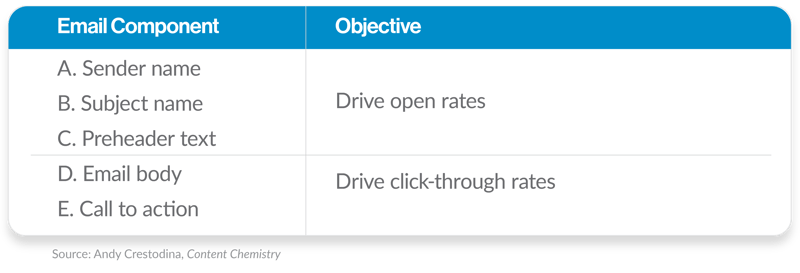
A. Sender Name
This is simple. Make sure your email sender name is personal. An email from “John Gulino, CEO” is more likely to get read than “promo.list@conglomerate.com. Format the sender name as if you’re sending a personal, handwritten note.
B. Subject Line
The subject line is your “grabber.” A long rambling subject line gets passed by. A great subject line is short, piques interest, and offers a benefit. Short is important because we only see the first 7 or so words of a subject line on our mobile phone screen.
Grabbing interest is about psychology. Curiosity hasn’t really killed any cats, but curiosity inspires us to open an email. “Great content that drives inflows” is likely to pique the interests of investment marketers. This subject line also provides the key benefit sought by investment marketers: “inflows.” An email subject line that offers a how-to path to success is often a winner.
Example subject lines designed to pique interest include:
- This is going away...
- Save 40% on investor content
- Could AI write your newsletter?
- Enjoy 50% off your annual subscription
- Fees waived on new fund
Top-performing words can also make a difference. Marketing research companies track the effectiveness of millions of subject line words.
Top-performing subject lines often contain the words below, among others:

Note that one word in this list only two letters: G-O. Brevity is key to email open rates.
C. Pre Header
Preheader text is the third element of an email preview. The preheader uses the first words of your email message body or short custom text. Custom text works best. However, don’t make the custom text too long, or email software will cut off and truncate your verbiage.
Email marketers use the preheader to increase the likelihood of a recipient opening your email. Would your ideal client click on this? Do the subject line and preheader text work together? If your answers are yes, your preheader text is ready (or ready to be tested, as we discuss in our next chapter: Optimization). Here’s an example from the prestigious British digital and print magazine, The Economist:
Sender: The Economist
Subject Line: Enjoy 50% off an annual subscription
Pre-Header: It’s a wonderful time to discover more
In the body of the email, they convinced the reader to“Explore the events and trends shaping our world...” That worked. This writer bought a digital subscription. The Economist was founded in 1843 but has a growing global readership in the digital era. With the right subject line and preheader text, you can attract the audience you seek, too.
D. Email Body
Email formats vary widely. Some use rich visuals. Others use plain text. Whatever format you use, you can measure the success of your email body based on click-through rates.
Key factors to consider:
- Mobile Friendly: It’s easy to test a draft on your own mobile device first.
- Personal: Make the tone conversational, not a sales pitch.
- Faces: Include a headshot of the author or a company executive, for example. People respond visually to faces.
- Clickable: Offer the reader multiple places to click, such as a headline, an image, or words in the text. This makes it easy for the reader the moment they’re ready to take action.
E. Call-to-Action (CTA)
An effective call to action is critical. The best CTAs attract attention, offer a benefit, and “close the deal” with a strong verb.
For desktop screens, CTA’s should be easy to find and click. A bright, colorful on-screen button is a go-to choice.
For mobile devices, the CTA should be positioned in the lower center of the screen and sized to enable an easy click by the reader’s thumb or forefinger.
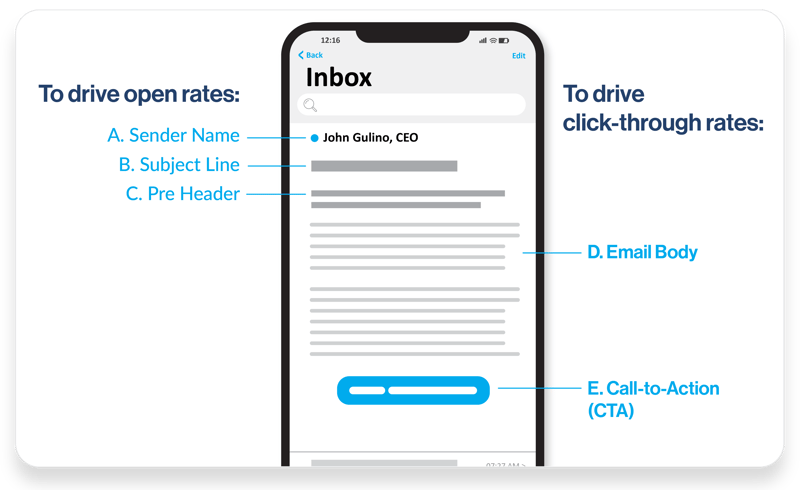
B. Social Media for Content Promotion
You will need to make sure your compliance, record keeping, and technology infrastructure and procedures are in place and robust before promoting your content since regulators consider your social media communications to be advertising.
The Dynamic Duo
There are two key social media to promote investment-related content: LinkedIn and Twitter.
LinkedIn is an avenue to share thought leadership and to direct your audience to your company profile and website for a deeper dive into your content. LinkedIn can also be used to promote events such as webinars and conferences.
Twitter is better suited for micro-content due to its 280-character maximum length, although you can expand your content by using a thread or adding visuals, audio, website links, or even carousels. Twitter is effective for amplifying your thought leadership or highlighting key members of your team and driving viewers to your longer content.
Broad social media campaigns may also include Facebook, particularly for personal finance, or Instagram, for visually-oriented content or to reach younger audiences.
LinkedIn to Engage Professionals
LinkedIn is the world’s largest professional social network, with over 185 million users in the US and 875 million users worldwide. Financial advisors use LinkedIn more than any other online social channel, more than the Wall Street Journal, Bloomberg, Barron’s, and the Financial Times.
LinkedIn is recognized for its lead generation potential and the wide variety of financial and investment content.

You can start promoting content on LinkedIn in two places: your company profile page and the pages of team members. You can also advertise on LinkedIn.
Each piece of content must be carefully written and designed for engagement. Posts with an engaging featured image and title generate more views.
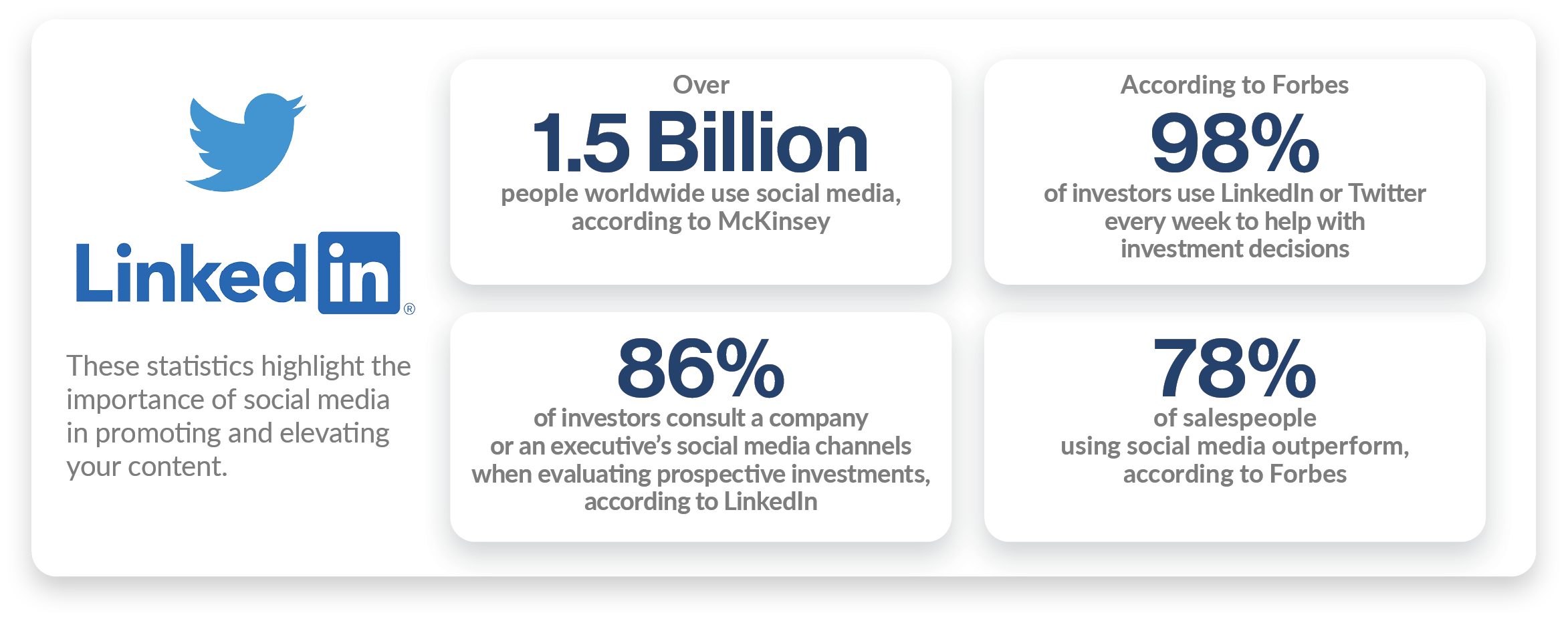
Twitter to Broaden Your Reach
Goldman Sachs has nearly a million followers on Twitter. Goldman uses its Twitter feed to highlight its thought leaders and their insights, promote company events, and drive online engagement and traffic to its website. Twitter increases the firm’s reach. Goldman uses a creative combination of text, video, audio, and graphics to create and sustain a compelling experience beyond Twitter’s 280-character limit for Twitter posts.
Some asset managers will use Twitter to humanize how they relate to their followers. Some companies will post snapshots and selfies from corporate events. Some CEOs will even post personal or family notes. Each firm must find the right balance between formal and informal content based on how they wish to relate to clients and prospects.
Twitter can be used for real-time communication. Subject to compliance oversight, forward-thinking financial services firms use Twitter to share breaking news with their constituencies or to sustain online conversations with followers.
Although some asset managers are active users of Twitter and other social media, compliance considerations and resource constraints limit social media usage for others.
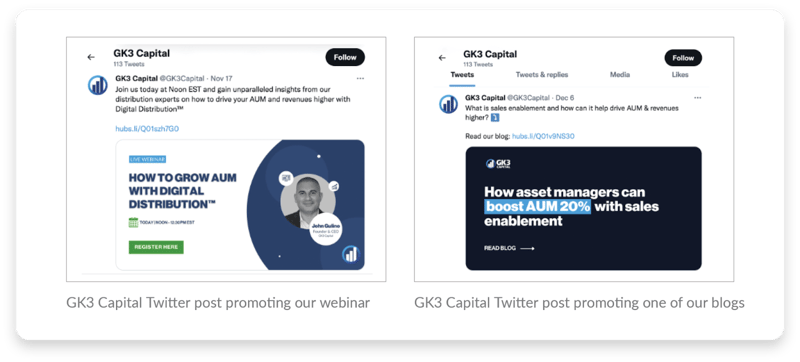
C. Digital Advertising: Grow Your Audience
Digital advertising can dramatically broaden the reach of any campaign to promote your content. Digital advertising is forecasted to be a $600+ billion marketplace:
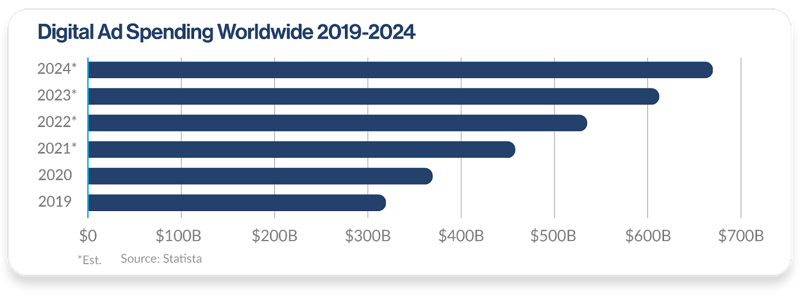
At GK3 Capital, we combine organic and paid media to promote your content online. We recommend:
- Organic social media to retain assets
- Paid social media to raise assets
The combination can be powerful. Organic social media, which includes your profile, postings, and followers, establishes your online presence and reputation.
An effective organic social media program can help you retain assets. With paid social media, you broaden your visibility and reach new potential customers.
A well-crafted and well-executed paid social media program can assist you in raising assets. A truly effective digital strategy combines both organic and paid approaches.

The Big Three
For financial services, online advertising starts with the “Big Three:” LinkedIn, Facebook, and Programmatic.
1. LinkedIn: The Leading Professional Social Network
We use a six-step approach to advertising on LinkedIn:
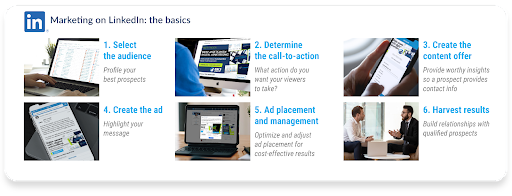
2. Facebook: The King of Social Media
Facebook is the leading social platform, with an estimated 239+ million users in the US and 2.9+ billion users worldwide. Facebook is the largest social media platform in the world.
With custom targeting, Facebook has the potential to provide a high return on advertising dollars for financial services firms. We often start paid media campaigns for asset managers and wealth managers on LinkedIn. We use Facebook to broaden a firm’s reach to build relationships with additional prospects, further engage customers, and drive additional website traffic.

3. Programmatic: Automated Ads Across the Web
Programmatic uses technology and data to automate and optimize online advertising. Nearly 90% of digital display ad spending is programmatic.
In programmatic advertising, practitioners use centralized platforms to bid on ad inventories in real-time across the web, adding algorithms and testing to reduce costs and optimize results.

D. Video as Content and to Promote Content
How do your clients prefer to receive information and learn? Some like to read. Some like to listen. Many like to watch.
As a result, video has been sweeping the asset management industry as a marketing and communications tool. According to HubSpot and Nielsen, online media consumption more than doubled in the US during the pandemic. On average, we now watch a record 19 hours per day of online video:
Many of your clients prefer the ease and speed of learning about you and receiving updates via video. Video can also be a powerful tool in your social media outreach and can be included in your social media posts.
Production is important. Viewers expect a quality experience. While social media can be very informal, just holding up your mobile phone in a conference room is not always sufficient. Video graphics, if well done, can help deliver financial information quickly.
Highlighting senior members of your team and portfolio managers in video helps build confidence and trust with current and future investors. Video is also well-suited for case studies and storytelling. Video outlooks are an effective way to highlight your thought leadership and insight and gain the respect of your audience. Some investments are well-suited to video, such as real estate.
Promoting Content with Videos and Promoting Video Content
Video can be used to drive traffic to your content offerings and your website. Video can also be content unto itself. Video can be embedded in your social media posts, and on your website. You can even consider your own video channel on YouTube or Vimeo. Whichever way you utilize video, you need user-friendly technology to host your video and monitor results.
At GK3, we use Wistia to host our videos and to track and optimize performance. Wistia offers custom branding and lacks the intrusive advertising of other platforms.
With Wistia, we can quickly add calls-to-action (CTAs) to guide viewers through the next steps of their discovery process. We can add links to get viewers to dive deeper into your website. Wistia also can help you turn viewers into leads with popup email-collection forms.
At GK3, we start by helping clients write and produce video content. We then pursue multiple avenues to promote your video content and maximize your ROI:
A. Customize - we customize your video platform to elevate your brand and company profile.
B. Generate Leads - we add calls-to-action and forms so you can capture new leads and follow up with viewers.
C. Measure and Optimize Results - we use analytics and key metrics to measure and optimize results:
- Play rate
- Percentage of videos viewed
- CTAs clicked
Heat maps highlight the most viewed parts of your video and let you know what engages a specific viewer.
Video has become a key medium for asset managers.
E. Promoting Content with Search
Every moment, people search online for information and answers to their questions. As a result, you are able to promote your content through:
- Search Engine Optimization (SEO)-organic
- Search Engine Marketing (SEM)-paid
The goal of SEO and SEM is to get your content to the top of a Search Engine Results Page (SERP), since most users stop at the first page of search results. The top three results in a Google search get half the clicks, on average. Higher search rankings generate more traffic to your website or content.
Keywords and Key Phrases
SEO and SEM matters. You want potential clients to find you, your content, your website, and what you offer.
As potential clients go online to search for answers or resources, they type in keywords, keyphrases, and questions into their search engine, most likely Google. You need to align your content with these queries, an important part of making your SEO and SEM a success. Keywords should be included in your headlines and copy and even in the meta tags for your illustrations, charts, or photos.
At GK3, we use keyword search tools such as Semrush or Google Keyword Planner to inform our content creation for clients.
Financial Advisers Versus Asset Managers
Search may play a different role in your digital promotion activities depending on the nature of your business. For example, financial advisers are looking for prospects they don’t know or whom they have never met. An adviser specializing in tax-advantaged real estate strategies may want to optimize their content for investors searching for:
- “qualified opportunity zones”
- “QOZ”
- “How to defer gains on real estate”
- “1031 exchange”
This financial advisor may benefit from SEO and SEM targeting these keywords and topics to attract prospective clients to their content and website.
In contrast, asset managers can acquire lists of the intermediaries or institutions they wish to reach, with contact information and even comprehensive data on prospects’ investment preferences and activity. Acquiring this data is critical since investment professionals are unlikely to use search in their investment selection process. A due diligence analyst is unlikely to Google for a “low beta large cap growth manager with low correlation to indices.”
As reflected above, search will play a varying role in marketing based on the nature of your business.
Intent Matters
It is also important to understand the concept of intent for SEO and SEM. There is a high level of intent motivating an online search by a financial advisor’s prospective investors. Prospects are using search to find specific investment solutions or answers to investment questions. While the identity of a potential investor is not yet known, they are likely to have a high level of intent in their online search.
The process is very different for asset managers. The asset manager may have a database, for example, of all the chief investment officers of foundations who may be interested in their strategy. The identities of the potential investors are known. However, the level of intent for these investors may be unknown. As discussed above, this type of investor is unlikely to be using online search tools to find an asset manager. The asset manager may utilize a targeted email campaign to reach these potential investors rather than SEO or SEM. Until the prospect receives and responds to the email, their intent is unknown.
Once a contact shows interest in your content, whether through SEM, SEO, email outreach, or another marketing approach, you should consider using a landing page for that content on your website specifically created to resonate with the target audience you seek.
Balancing the Target Audience and Budgets
Effective content promotion requires careful planning. You should develop a written “buyer persona” reflecting the characteristics of each of your preferred prospect types. Understanding these buyer personas will help you determine the most effective types of content, as well as the most cost-effective ways to reach them. You must balance these considerations in your budgeting to optimize the return on your marketing investment.
F. Repurposing: Compound and Leverage Your Content
For maximum reach and results, don’t look at each piece of content in isolation. Repurposing content streamlines the content creation process and enables you to convert existing content into new formats with limited additional effort.
Begin with one long-form piece of content, such as an eBook, for example. Then, divide the eBook into smaller pieces of content, such as blogs and social posts, to distribute via multiple channels, such as email or social media. One premium content offer can become:

Each piece of additional content can be promoted across different channels or venues. At GK3 Capital, we utilized this process for our recent content program on Digital DistributionTM:
- We began with a video series as a premium content offer behind a gated form. Interested viewers provide their names and contact information to view the videos.
- We also created an eBook as a companion to the video series.
- To promote the video series and eBook, we published a series of blogs repurposed from the video scripts and eBook chapters. These blogs were distributed via email and were optimized for SEO.
- We also distributed the blogs via an email campaign using a database of financial services professionals, inviting recipients to view the videos or download the eBook.
- The blogs were then segmented into social media posts, effectively repurposing the “macro” content into “micro” content. The micro-content also offered readers the opportunity to view or read the premium content.
- We then added paid advertising and SEM to our budget to further promote the original content.
- All the micro content and promotional activities led back to our website and gated premium content.
- Ultimately, we created a complete content portfolio promoted across multiple platforms, all repurposed from the original video series. The campaign continues to drive traffic to our website, bring new potential clients, and inspire deeper relationships with our audience.
Conclusion
Promoting your content can dramatically increase your reach and effectiveness with your content marketing efforts. Unfortunately, many approach the promotion of content as an afterthought in the overall process, or as an unnecessary added cost. Make promotion a priority in your sales and marketing program and you'll accelerate your opportunities to attract and convert new customers.
Our final blog post in our series, 8 Steps to Creating Great Content that Attracts New Investors and AUM, discusses the role of Optimization in refining and constantly improving your content.
John Gulino is the Founder and CEO of GK3 Capital LLC. Experienced in all facets of distribution including management, direct sales, training, and development, John has been fortunate to represent some of the industry’s most respected and innovative financial institutions and has consulted with many more of the top asset management firms in the industry on how to better align their sales and marketing efforts.
Topics:


